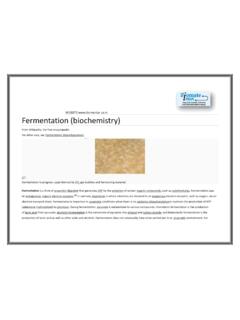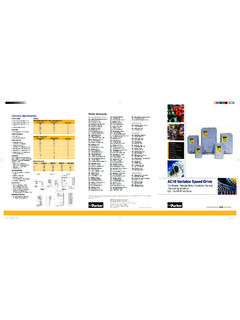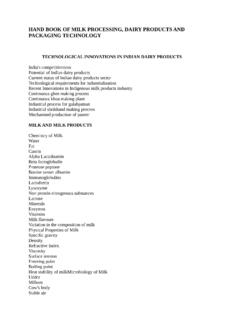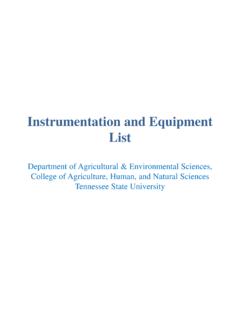Transcription of Q. sample preparation for FTIR & How to sample introduce ...
1 Q. sample preparation for ftir & How to sample introduce in the system? ftir sample preparation ftir sample cell designed according to nature of a sample . sample may be liquid/solid/gaseous. sample preparation for Solid sample . sample is mixed with KBr powder, Blend is compressed under 10 ton pressure to a small tablet/disc (diameter=1 cm, thickness=1-3 mm). Disc is placed in a disc holder & measured. Best method for solid sample b coz (over Nujol Mull process)..KBr is 100% transparent to IR radiation & shows no peak. So, peak will be obtained only because of sample . Method is used for qualitative analysis. It can t be used for quantitative analysis, because solid dispersion are not 100% transparent.
2 Solution preparation for liquid sample is dissolved & diluted in a non-aqueous solvent to get a clear solution is placed in cell & measured CCl & CS as solvent because not absorbing radiation range. Nujol-Mull process sample is triturated with liquid paraffin to get paste , which is placed between kbr discs & measured process,( liquid paraffin(Mulling agent) which should be free from traces of H O). Bonds of liquid paraffin have their own absorption, by which more complex spectrum achieved. For liquid Concentration should be in range mg/ml KBr cells.(gap thickness to 1 mm) Solution is prepared in non-aqueous solvent like CS & CCl Liquids are measured as such or after suitable dilution. But, solvent also shows absorbance peaks which is difficult to separate.
3 Thus solvent should be so selected that it shows in overlapping spectrum for measurement of liquid, sample cell made of NaCl should be used. Gaseous Measured directly after purification Gaseous sample is made free from CO & H O. That s why, For CO --KOH is used & for H O--- CaCl used. Gaseous cell which pressured & certain volume (5-50 mm thickness) FT-IR sample preparation 1. LIQUIDS: Place a small drop of the compound on one of the KBr plates. Place the second plate on top and make a quarter turn to obtain a nice even film. Place the plates into the sample holder and run a spectrum. If the sample is too concentrated, separate the plates and wipe one side clean before putting them back together.
4 The KBr plates must be thoroughly cleaned after this procedure to prevent contamination of future samples . Wipe the windows with a tissue, then wash several times with methylene chloride (or another solvent that will take off you sample ), then ethanol. Use the polishing kit in the lab to polish the window surface. Wear gloves to prevent fogging. The cleaned surface should be clear and free from scratches. 2. SOLIDS (in solution): Prepare a concentrated solution of your compound in a suitable solvent ( CH2Cl2). Attention: Remember that all solvents containing water will either dissolve the KBr plates or make them fog up. The broad water band might also mask important bands of your compound. There are several ways to do this depending how much material you have at hand: either you place a small amount (2-5 mg) of your compound directly on the plates and add one drop of solvent, or you dissolve it in a small test tube first and transfer this solution with a pipet onto the IR plates.
5 Reminder: Obtain a spectrum of solvent as well, or run the pure solvent as a baseline to automatically subtract it. The KBr plates must be thoroughly cleaned after this procedure to prevent contamination of future samples . Wipe the windows with a tissue, then wash several times with your solvent, then ethanol. Use the polishing kit in the lab to polish the window surface. Wear gloves to prevent fogging. The cleaned surface should be clear and free from scratches. 3. SOLIDS (as Nujol mulls) Alternative methods to obtain IR spectra of solids are Nujol (mineral oil) mulls between KBr plates. Remember that Nujol by itself shows a characteristic spectrum! Good results are obtained by this method only if the average particle size of the solid is somewhat less than the wavelength of light the particles are to transmit.
6 samples should therefore be ground in a mortar to reduce the average particle size to 1 to 2 microns. About 5 to 10 mg of finely ground sample are then placed onto the face of a KBr plate, a small drop of mineral oil is added and the second window is placed on top. With a gentle circular and back-and-forth rubbing motion of the two windows, evenly distribute the mixture between the plates. The mixture should appear slightly translucent, with no bubbles, when properly prepared. Place the sandwiched plates in the spectrometer and obtain a spectrum. Ideally, the strongest band should have a transmission ob 0 to 10% and should not be totally absorbing for more than 20 cm-1. Attention: If the bands are distorted (show fronting or tailing) the particle size is too great and some radiation incident on the mull has been scattered out of the sample beam (Christiansen scattering).
7 If a better spectrum is required reduce the particle size further. The KBr plates must be thoroughly cleaned after this procedure to prevent contamination of future samples . Wipe the windows with a tissue, then wash several times with methylene chloride, then ethanol. Use the polishing kit in the lab to polish the window surface. Wear gloves to prevent fogging. The cleaned surface should be clear and free from scratches. 4. KBr pellets/disks (for solid samples ) In order to prepare a kbr pellet , follow the procedure given below: sample /KBr ratio The concentration of the sample in KBr should be in the range of to 1%. The pellet is much thicker than a liquid film, hence a lower concentration in the sample is required (Beer's Law).
8 Too high a concentration usually causes difficulties obtaining clear pellets. The IR beam is absorbed completely, or scattered from the sample which results in very noisy spectra. sample preparation Although a homogeneous mixture will give the best results, excessive grinding of the potassium bromide is not required. The finely powdered potassium bromide will absorb more humidity (it is hygroscopic) from the air and therefore lead to an increased background in certain ranges. Make sure to work fast. Transfer some KBr out of the oven (ATTENTION: the oven is at 100 oC - you can easily burn yourself!) into a mortar. Add about 1 to 2 % of your sample , mix and grind to a fine powder. For very hard samples , add the sample first, grind, add KBr and then grind again.
9 The sample must be very finely ground as in the Nujol mulling technique to reduce scattering losses and absorption band distortions. Take two stainless steel disks out of the desiccator. Place a piece of the precut cardboard (in the tin can next to the oven) on top of one disk and fill the cutout hole with the finely ground mixture. Put the second stainless steel disk on top and transfer the sandwich onto the pistil in the hydraulic press. With a pumping movement, move the hydraulic pump handle downward. The pistil will start to move upward until it reaches the top of the pump chamber. Then, move the pump handle upwards and pump until the pressure reaches 20,000 prf. Leave for a few seconds and with the small lever on the left side, release the pressure (hold until the sample and pistil are all the way down).
10 Remove the disks and pull apart. Remove the film, which should be homogenous and transparent in appearance. Insert into the IR sample holder and attach with scotch tape. Run the spectrum. After use, the mortar and pistil should be cleaned with acetone and double distilled water, and be put back on top of the oven for drying. Reasons for Cloudy Disks 1. KBr mixture not ground enough 2. sample was not dry 3. sample : KBr ratio high 4. pellet too thick 5. Bolts not tightened sufficiently. 6. sample has low In order to obtain any meaningful information from your IR spectrum, you need to have a decent spectrum with sharp peaks, , with 'good' intensity and good resolution. Ideally, the largest peak, which is caused by your compound, should have an intensity of 2-5%T.











